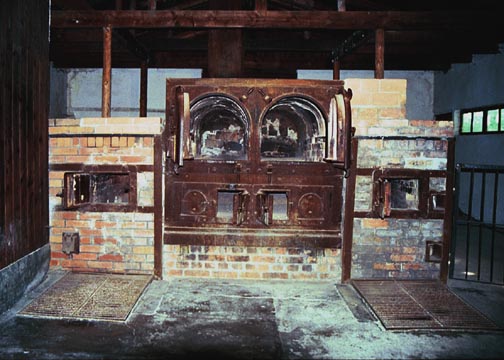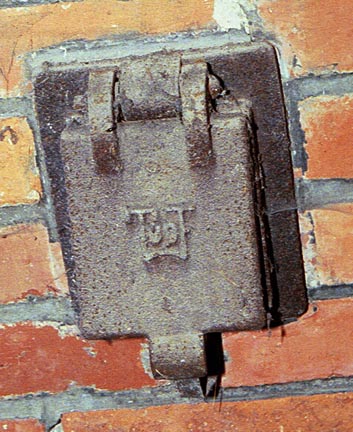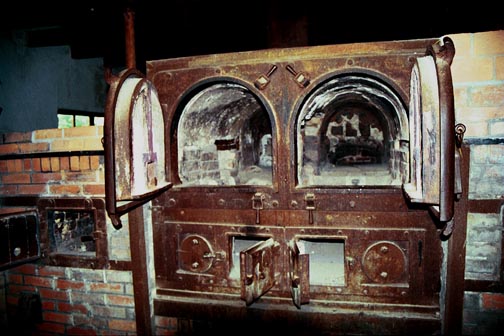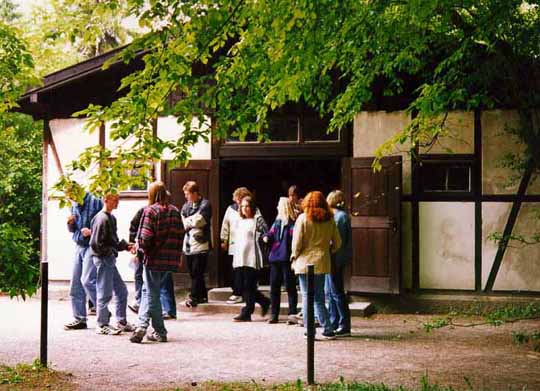Old Crematorium at Dachau"Next, I was led to the storage warehouse. This large building contained the naked dead bodies of over 4,000 men, women and children, thrown one on top of the other like sacks of potatoes. The odor was terrific. I vomited three times in less than five minutes. It was the most revolting smell I had ever experienced...Next to the Warehouse of dead bodies, was the crematory itself; a large, double furnace, each capable of being stuffed with five or six copses at once. The dead bodies were dragged from the Warehouse, jammed into the red-hot furnace. But even then, the Nazis were not through! The ashes of the victims were used as fertilizer for the flower gardens and the vegetable gardens - no wonder the flowers were so beautiful!" Lt. Col. Walter Fellenz, 42nd Rainbow Division, from his Report to the Commanding General, 6 May 1945  The photograph above, taken in May 2007, shows the small one-room, half-timbered cabin which was built in 1940 to house the first crematory oven. The building is located in a stand of trees to the east of the new crematorium and directly across from it. The door to the old crematorium faces south, looking towards the gate house. A wall with an iron gate now closes off the crematorium area from the gate house through which new arrivals entered the prison compound. The new crematorium was the "Warehouse" for dead bodies, which contained 4,000 corpses, according to the report written by Lt. Col. Walter Fellenz that is quoted at the top of this page. Actually, there were two morgue rooms in the new crematorium which contained no more than 200 bodies. Apparently, Fellenz did not see the five ovens in the new crematorium. The interior of the old crematorium is shown in the photos below, which were taken in May 2001. Several bodies could be burned at one time, depending on the size of the corpses. The photo below, taken from the open doorway, shows three walls of the old crematorium with a gated narrow corridor which provides access to the area behind the oven. The floor of the building is concrete and there are two large grates on the floor.  The tiny door at the bottom of the oven, on the left hand side in the photo above, is shown in a close-up in the photograph below. It has the logo of the Topf Company which manufactured all the ovens used in the concentration camps.  The photo below shows the inside of the two retorts and the two small doors which were used to remove the ashes. On the far left is the door that was used to put in the fuel used for burning.  In the early days of the Dachau concentration camp, there were few deaths compared to the travesty which took place after January 1945 when thousands of survivors from the eastern death camps were brought to the over-crowded camps in Germany, including Dachau. Almost half of the deaths in the Dachau camp occurred in the final five months of the war, as the typhus epidemic raging in the eastern camps spread to the German camps, carried by the new arrivals. In the first years of the camp, before World War II started on Sept. 1, 1939, only a small crematorium with one oven was needed. In all of the concentration camps, the corpses of those who died in the camps were burned on the orders of Heinrich Himmler in an effort to prevent the spread of disease and the contamination of the ground water. But even this did not stop the devastating typhus epidemics which accounted for the deaths of untold thousands of prisoners in the Nazi camps. The area where the crematoria are located was off limits to the prisoners and hidden from them by a row of poplar trees on the west side of the prison compound. However, the crematoria area was close enough to the prison barracks that the inmates could smell the burning flesh when bodies were cremated.  New CrematoriumBack to Table of ContentsHomeThis page was last updated on March 13, 2008 |